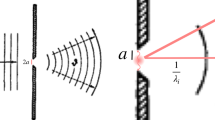Abstract
A close examination of the Maxwell-Lorentz theory of electrodynamics reveals that polarization and magnetization of material media need not be treated as local averages over small volumes — volumes that nevertheless contain a large number of electric and/or magnetic dipoles. Indeed, Maxwell’s macroscopic equations are exact and self-consistent mathematical relations between electromagnetic fields and their sources, which consist of free charge, free current, polarization, and magnetization. When necessary, the discrete nature of the constituents of matter and the granularity of material media can be handled with the aid of special functions, such as Dirac’s delta-function. The energy of the electromagnetic field and the exchange of this energy with material media are treated with a single postulate that establishes the Poynting vector S = E × H as the rate of flow of electromagnetic energy under all circumstances. Similarly, the linear and angular momentum densities of the fields are simple functions of the Poynting vector that can be unambiguously evaluated at all points in space and time, irrespective of the type of material media, if any, that might reside at various locations. Finally, we examine the Einstein-Laub force- and torque-density equations, and point out the consistency of these equations with the preceding postulates, with the conservation laws, and with the special theory of relativity. The set of postulates thus obtained constitutes a foundation for the classical theory of electrodynamics.
Similar content being viewed by others
Suggested Reading
J D Jackson, Classical Electrodynamics, 3rd edition, Wiley, New York, 1999.
L Landau, E Lifshitz, Electrodynamics of Continuous Media, Pergamon, New York, 1960.
R M Fano, L J Chu and R B Adler, Electromagnetic Fields, Energy and Forces, Wiley, New York, 1960.
R P Feynman, R B Leighton and M Sands, The Feynman Lectures on Physics, Addison-Wesley, Reading, Massachusetts, 1964.
M Mansuripur, Field, Force, Energy and Momentum in Classical Electrodynamics, Bentham e-books, 2011.
M Mansuripur and A R Zakharian, Maxwell’s macroscopic equations, the energy-momentum postulates, and the Lorentz law of force, Phys. Rev. E. Vol.79, 026608, 2009.
N L Balazs, The energy-momentum tensor of the electromagnetic field inside matter, Phys. Rev., Vol.91, pp.408–411, 1953.
M Mansuripur, Resolution of the Abraham-Minkowski controversy, Optics Communication, Vol.283, 1997–2005, 2010.
L Allen, M J Padgett and M Babiker, The orbital angular momentumof light, Prog. Opt., Vol. 39, pp.291–372, 1999.
M Mansuripur, Spin and orbital angular momenta of electromagnetic waves in free space, Phys. Rev. A, Vol.84, 033838, 2011.
W Shockley and R P James, Try simplest cases discovery of hidden momentum forces on magnetic currents, Phys. Rev. Lett., Vol.18, pp.876–879, 1967.
P Penfield and H A Haus, Electrodynamics of Moving Media, MIT Press, Cambridge, 1967.
M Mansuripur, Trouble with the Lorentz law of force: Incompatibility with special relativity and momentum conservation, Phys. Rev. Lett., Vol.108, 193901, 2012.
A Einstein and J Laub, Über die im elektromagnetischen Felde auf ruhende Körper ausgeübtenponderomotorischen Kräfte, Annalender Physik, Vol. 331, pp.541–550, 1908; the English translation of this paper appears in Einstein’s Collected Papers, Vol.2, Princeton University Press, 1989.
A Ashkin and J M Dziedzic, Radiation pressure on a free liquid surface, Phys. Rev. Lett., Vol.30, pp.139–142, 1973.
R Loudon, Theory of the forces exerted by Laguerre-Gaussian light beams on dielectrics, Phys. Rev. A, Vol.68, 013806, 2003.
M Mansuripur, Radiation pressure and the distribution of electromagnetic force in dielectric media, Proc. SPIE, Vol.5930, 59300O-1–7, 2005.
M Mansuripur, Radiation pressure and the linear momentumof the electromagnetic field in magnetic media, Optics Express, Vol.15, pp.13502–13518, 2007.
M Mansuripur, Solar sails, optical tweezers, and other light-driven machines, in Tribute to Joseph W. Goodman, edited by H J Caulfield and H H Arsenault, special issue of Proc. SPIE, Vol.8122, 81220D, 2011.
G K Campbell, A E Leanhardt, J Mun, M Boyd, E W Streed, W Ketterle and D E Pritchard, Photon recoil momentum in dispersive media, Phys. Rev. Lett., Vol.94, 170403, 2005.
R N C Pfeifer, T A Nieminen, N R Heckenberg and H Rubinsztein-Dunlop, Colloquium: Momentum of an electromagnetic wave in dielectric media, Rev. Mod. Phys., Vol.79, p.1197, 2007.
S M Barnett, Resolution of the Abraham-Minkowski Dilemma, Phys. Rev. Lett., Vol.104, 070401, 2010.
R V Jones and B Leslie, The measurement of optical radiation pressure in dispersive media, Proc. Roy. Soc. London, Series A, Vol.360, pp.347–363, 1978.
M Mansuripur and A R Zakharian, Whence the Minkowski momentum? Optics Communications, Vol.283, pp.3557–3563, 2010.
M Mansuripur, Deducing radiation pressure on a submerged mirror from the Doppler shift, Phys. Rev. A, Vol.85, 023807, 2012.
Author information
Authors and Affiliations
Corresponding author
Additional information
Masud Mansuripur (PhD 1981, Stanford University) is Professor and Chair of Optical Data Storage at the College of Optical Sciences of the University of Arizona in Tucson.
Rights and permissions
About this article
Cite this article
Mansuripur, M. On the foundational equations of the classical theory of electrodynamics. Reson 18, 130–155 (2013). https://doi.org/10.1007/s12045-013-0016-4
Published:
Issue Date:
DOI: https://doi.org/10.1007/s12045-013-0016-4




